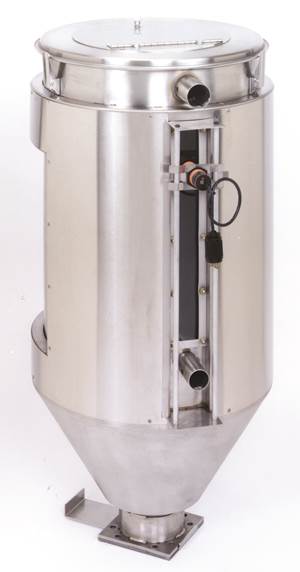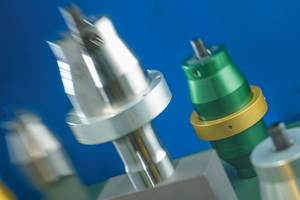The Importance of Gate Geometry
Gate size and shape—unlike gate location—don’t often get the attention they deserve. Many common assumptions about gate geometry deserve to be challenged
During the first 14 years of my career, when I was designing and building injection molds, gating and runners were not really a focus. I was concerned with building a robust tool and had no idea what was going on over at the molding side. In 2002 when I made a move from the mold shop to the molding floor, gating and runners jumped out at me right away as lacking standards.
I started studying gates and runners when I was developing in-mold degating with tab gates. To create a clean break, gate geometry and gate land were critical. I saw there was nothing consistent in gate geometry between material or part size from mold to mold. I saw large parts with gates half the size of the gates on a smaller part running the same material. I observed that the main focus in mold designs was on gate location on the part, and gate orifice geometry was basically shoot-from-the-hip.
For in-mold degating, I needed to have the gate as thin as possible and a minimal land to assist with a clean break. I started learning a lot about plastic pressures while I was welding and modifying gates on numerous tools. I remember the concerns people expressed about my making the gates thinner, but they gave no specific data to back up their concerns. It was very confusing when there was no standard for gates or runners, and sizes and geometries were all over the map.
GATE SIZE VS. SHAPE
Through the process of modifying gates on various tools I learned some very interesting things. Just because you decrease the gate size or thickness, it does not always mean that plastic pressure will increase. And it increasing a gate thickness or size does always not mean your plastic pressure will drop. I mention this because it goes against common assumptions.
Typically, when a gate is made smaller you can expect to see a change in plastic pressure because you have reduced the volume of the gate orifice. But a change in gate size or volume does not always produce a noticeable change in plastic pressure. I found out that when I decreased the gate thickness and had an increase of plastic pressure, I could widen the gate to compensate and reduce the plastic pressure. I also learned that the gate land can affect plastic pressure.
It is important not to focus on the gate as the only restriction to plastic flow. Many people overlook the role of hot-drop tip orifices. I have often seen people open up gates or runners when the hot-drop tip was the restriction—as would occur, for example, when a hot runner feeds into a cold runner.
BREAKING UP JETTING
Before I get into some gating details, I want you to understand my basic concept. Most of you readers understand fountain flow in mold filling. Let’s assume you have a round runner and experience textbook fountain flow. That’s what happens when you take this volume of flow and ram it through a small round orifice into the large space of the cavity. Sure, you could gate into a side wall or have a restriction in front of it to break up the concentrated flow of plastic. But what if you could change the gate geometry to improve the transition from the runner to the part?
My focus here will be primarily on cashew and sub-gates, but I learned the concepts when working with tab gates. I like to use a pressure washer as an example to help paint a mental picture. If you were to put a tip with small round orifice on your pressure washer, what type of stream would you expect to see? Now if you put a tip with a rectangular orifice that was thin and wide, what would the flow look like? The difference is pretty drastic between a small, straight, jetting stream and a fanned-out stream. With the thin-and-wide concept I have been able to reduce cycle times with a quicker gate seal, maintain or reduce fill pressures, eliminate high gates or vestiges on cashew gates, help minimize gate blush, eliminate jetting, eliminate pulls, and eliminate flaking.
One example is a PC/ABS part where I was addressing high gate marks. It had a cashew gate with a 0.040-in. diam. orifice. We changed the orifice from 0.040 in. round to a rectangular shape of 0.020 x 0.080 in., which increased the gate volume. In this case we not only were able to help reduce the high-gate defect but were able to drop the fill pressures from 16,000 to 11,000 psi. This created a larger process window on a part that had struggled with flash and shorts.
In another example we were able to eliminate two defects—jetting and pulls—on a larger glass-filled PP part that was causing a lot of scrap. The 750-ton tool had no process window allowance to address the defects. The part had two cashew gates with 0.110-in. diam. round orifices. In this case I could go thinner but not wider because the geometry of the taper would not allow it. I started by welding up the orifice and going from the 0.110 in. round to a 0.050 x 0.110 in. rectangle. I was concerned about increasing fill pressures because I was reducing the orifice volume.
When we ran the tool after the change there was no increase in fill pressures. Jetting was improved but we still had some issues with the pulls. The pulls were the result of the part shrinking away from the gate area before ejection. So, we had another idea: If we made the gate thinner than 0.050 in., would it break while the part was shrinking away, reducing the pull defect? Because the first change had no impact on fill pressures we thought it was worth a shot. We welded the gate orifice and reduced it from 0.050 x 0.110 to 0.025 x 0.110 in.
This time around our fill pressures did increase from around 10,000 psi to 13,000 psi but the pulls were eliminated and the process window drastically improved, with less jetting and thousands of dollars in scrap savings.
I worked on a program of PP parts that were having high-gate issues. In this case the cashew gates were 0.040 in. diam. We went to 0.020 x 0.080, and the high gates were eliminated, and there was no increase in fill pressures.
GATE SIZE, SHAPE & TAPER
Accompanying images show geometry alternatives to the industry standards. The D-gate style sub-gate versus the standard simulates the thin/wide concept and will provide much cleaner gate breaks than the standard sub-gate. And with this style in one case I was able to reduce gate-seal time by 5 sec, saving an equal amount in overall cycle time.
Another important part of the gate geometry is the mass and taper leading up to the orifice. It should always taper down to the orifice to prevent flow restrictions. If it doesn’t it can cause an increase in fill pressures and in some cases flow imbalances.
One example of this was on a two-cavity mold with sub-gates. This mold had a righthand and lefthand part that were exactly mirrored so there was no difference between cavity size but the cavities were significantly unbalanced. I was asked to open up the sub-gate orifice on the cavity that was short even though the gate orifices were the same size (not always a good idea). After opening the orifice to where it had 50 % more volume, I knew something was not right. I looked closely and found the sub-gate tapers were slightly different, not enough to be noticeable without very close examination. I increased the taper on the cavity that was short to match the taper on the other cavity. Wow, what a change! The cavity that had been short now filled way ahead of the other cavity.
With the D-Style sub-gate the taper is taken out of the equation for flow restrictions because there is not a gradual taper of mass like the standard sub-gate. You can also sub-gate into angled walls, where when using a standard sub-gate you would end up with a gate vestige. Also, you can gate into shorter walls than with a standard sub-gate. I have gated into cavity walls that were 0.125 in. tall. You have endless opportunities with D-gate orifices. You can increase the tip of the cone on the D-gate to create a wider orifice. It is important to understand the volume of the gate orifice. You can use a much thinner gate orifice because you are increasing volume with the extra width.
THINNER CAN BE BETTER
Pretty much everyone with whom I have discussed gate geometry over the years automatically assumes you will have an increase in fill pressures if you go thinner in gate dimensions. I have found it’s more about volume, which can be maintained by increasing the width whenever I go thinner. Some materials prefer the higher shear with thinner gates.
Here’s another example: We had a trailing ring gate on an ABS part with only a 0.006-in. gate orifice. On a prototype I had no concerns with fill pressures using a 0.007-in.-thick gate. When we ran the new tool with a 0.006-in. ring gate, our fill pressures were touching the limits on the high side. Needless to say, I was surprised because I had not seen this on the prototype, but the production tool was not an apples-to-apples comparison regarding cavitation or part geometry. We increased the gate thickness to 0.012 in., ran the tool, and the pressures did not drop at all. It wasn’t the gate causing the high pressures.
Now think in reverse, If we had built the tool with a gate that was 0.012-in. thick and the process was pressure limited, you would have thought I was nuts if I suggested we reduce the gate thickness to 0.006 in. You probably would have bet everything you owned that the pressures would have increased. A thickness reduction of 0.006 in. may not seem like much, but it was a 50% reduction in gate volume.
Related Content
Bozzelli’s Guide To Specifying a Dryer
Here's a list of 17 things to do when looking for new drying equipment.
Read MoreUltrasonic Welding: Tips, Techniques, and Troubleshooting
In this collection of content, we provide expert advice on welding from some of the leading authorities in the field, with tips on such matters as controls, as well as insights on how to solve common problems in welding.
Read MoreGot Streaks or Black Specs? Here’s How to Find and Fix Them
Determining the source of streaking or contamination in your molded parts is a critical step in perfecting your purging procedures ultimately saving you time and money.
Read MoreFive Quick Steps Toward Better Blending
Rising costs of resins and additives, along with higher demands for quality and use of regrind, place a premium on proficient blending. Here are some steps to get you there.
Read MoreRead Next
See Recyclers Close the Loop on Trade Show Production Scrap at NPE2024
A collaboration between show organizer PLASTICS, recycler CPR and size reduction experts WEIMA and Conair recovered and recycled all production scrap at NPE2024.
Read MoreBeyond Prototypes: 8 Ways the Plastics Industry Is Using 3D Printing
Plastics processors are finding applications for 3D printing around the plant and across the supply chain. Here are 8 examples to look for at NPE2024.
Read MoreMaking the Circular Economy a Reality
Driven by brand owner demands and new worldwide legislation, the entire supply chain is working toward the shift to circularity, with some evidence the circular economy has already begun.
Read More

























